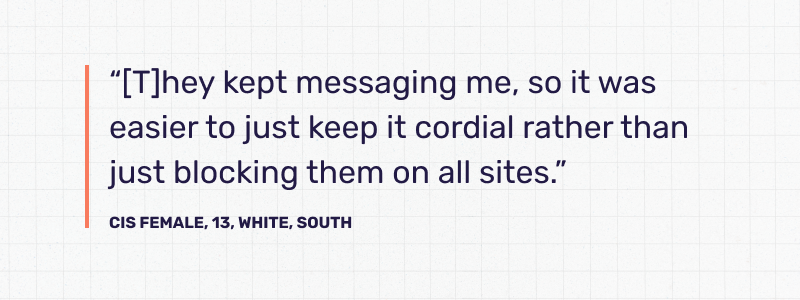New Research from Thorn: 22% of minors report having online sexual interactions with adults
February 7, 2023
4 Minute Read
What should children do when they experience harmful sexual interactions online?
At Thorn, we believe that’s the wrong question to ask – one that underscores the responsibility we too often put on children themselves to identify and report bad actors and harmful situations.
Our new research shows that we must do better when it comes to helping kids respond to online threats.
What’s the problem?
According to our latest annual monitoring research, Responding to Online Threats: Minors’ Perspective on Disclosing, Reporting, and Blocking in 2021, the features provided by platforms to help users block and report bad actors are simply insufficient in keeping kids safe.
At the same time, the study shows that children aren’t turning to offline support systems – like having conversations with parents and other trusted adults – even though they can play a critical role in protecting kids from harm.
In the absence of these offline support options, kids leverage the tools that platforms build in – like blocking and reporting – and have faith that they will be sufficient in defending them from online harm.
To this end, platforms are the first line of protection for their users, particularly young people.
And, while many companies are leaning into this responsibility, platforms’ systems and policies intended to protect young users are simply not keeping up with the risks they face online.
What does Thorn’s latest research show?
Our research found that an alarming 22 percent of minors report having online sexual interactions with adults—the same percentage that reports having sexual interactions with peers their own age.
Here are some key findings from this year’s monitoring report:
- Minors use online tools rather than offline support systems when addressing online sexual interactions. In response to potentially harmful online sexual interactions, youth were twice as likely to use online support tools—such as blocking or reporting—than to seek offline support from a parent or caregiver.
- Blocking remains minors’ most used online safety feature in controlling potentially harmful online interactions. 68% of minors blocked users when experiencing potentially harmful online interactions, while 50% used a reporting feature, 23% muted a user, and just 15% ignored them.
- Existing safety tools were insufficient in stopping repeat harassers. Online safety tools like blocking and reporting were not sufficient in preventing a harasser from recontacting minors. Approximately half of the children who utilized online safety tools experienced recontacts from online harassers. One in six minors who reported a user indicated their report was never resolved.
So, what’s next?
We – and many other key players in the online child safety space – have moved beyond believing we can simply restrict kids from the internet. Rather, we recognize the internet provides invaluable opportunities for kids to explore the world beyond their doorstep and connect to vibrant communities.
We also know that restricting access doesn’t work- kids will find other ways to get online. Therefore, we must meet kids where they are, and provide effective help when they need it.
Directing kids in danger to fractured systems not only fails to protect them but may further isolate them. That’s why we’re shedding light on the issue and calling on the child safety ecosystem to develop better solutions.
In the meantime, here are some steps we can take to help protect kids online:
- We can all be aware of the threats facing children and understand how kids are behaving online in general. This includes the all-too-common practice of self-generated child sexual abuse material (SG-CSAM), otherwise known as “nude selfie” sharing. Since 2019, Thorn has undertaken multiple research initiatives into SG-CSAM, a key area of concern for those working to combat online sexual exploitation. The research illuminates the scope of the issue, as well as the clear need for functional online safety tools and offline support systems that incentivize children to take action.
- If you’re a parent or other trusted adult, have conversations early and often. Visit Thorn for Parents to learn how to have productive and meaningful talks at every age that help you and your child connect and navigate online experiences safely.
- If you’re a tech company and want to learn about how to keep your online spaces safer for children, reach out to us at info@thorn.org. We believe that a better internet starts with your platform, and we’re here to help.
- Together, we can be a safety net for kids as they navigate online spaces.
Our full report, Responding to Online Threats: Minors’ Perspectives on Disclosing, Reporting, and Blocking in 2021, can be viewed here.
Related Articles
Stay up to date
Want Thorn articles and news delivered directly to your inbox? Subscribe to our newsletter.



